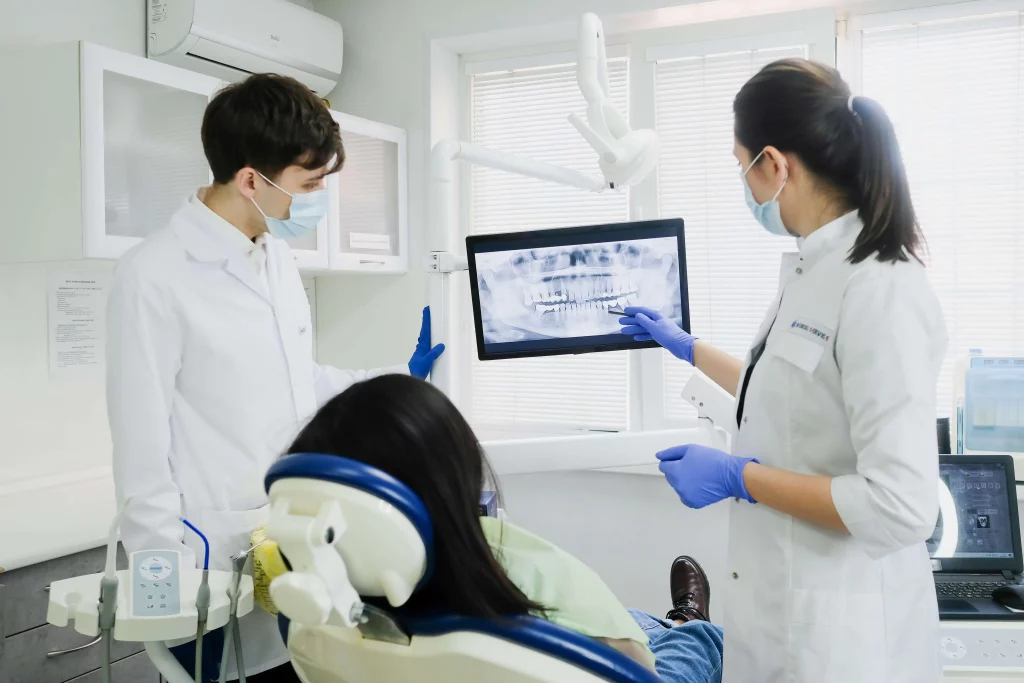Orthodontics
DIGITAL ORTHODONTICS
“It is possible to see what the teeth will look like as a result of orthodontic treatment before the treatment is done, in a simulation environment, as close to the end, by imaging the inside of the mouth with digital measurements.”
Examination in orthodontic treatment is one of the most important stages of the treatment process. Detailed examination of the face, jaw bones, muscles, joints, teeth and oral soft tissues are the main guiding elements in treatment planning.
Digital images, photographs and measurements taken from the patient during the examination phase guide treatment planning.
By using intraoral cameras with digital measurement technique, the image of the patient’s teeth can be transferred to the computer environment in a very short time. Thus, the image projected on the screen can be examined and discussed in detail with the person to be treated.
Digital Orthodontic Treatments
“Without wires and brackets, it is possible to be treated with transparent plates, thanks to computer-aided software!”
For our patients who apply for orthodontic treatment, we plan with a special software on the images that we transfer to the computer environment after digital intraoral scanning. In what manner and how much the teeth will be moved is calculated with a detailed study and the teeth are brought to the position they should be in the computer environment. The final image is poured into models through 3D printer and transparent plates are prepared on these models.
“IN CLEAR ALIGNER TREATMENTS WITH DIGITAL SCANNING SYSTEMS, YOU CAN SEE THE RESULT BEFORE STARTING THE TREATMENT.”
Growing kids’ Orthodontic Treatment
When you hear about orthodontic treatment, you would instinctively think of older kids and teenagers with misalignment and spacing problems. However, this is entirely untrue. Starting dental treatment at a young age is crucial for a child’s good oral health and aesthetic benefits. Most dentists recommend starting with orthodontic treatment early on or as soon as the permanent teeth have fully erupted. It is because orthodontic evaluation can be challenging, but the proper treatment can be offered by doing frequent exams. During the developmental stage, your child can receive successful therapy for any structural dysfunctions of the jaw, malocclusion or bite problems. Early detection helps prevent the need for extensive orthodontic treatment down the road. The doctor can often avoid extracting permanent teeth and performing jaw surgery by starting orthodontic therapy in childhood.
- A more accurate forecast of the development of permanent teeth.
- The capacity to enhance the look of your child
- The capacity to change behaviors, such as thumb-sucking or tongue-pushing, could contribute to developmental issues.
- Control over how the jaw grows to make room for new teeth
- Positioning teeth and lips in a more aesthetically acceptable and practical position.
- Temporary teeth come out too soon or too late
- Your child exhibits any harmful habit, such as finger-sucking
- Your child has a habit of pushing their tongue
- The child has an improper bite
- Your child is having a hard time biting or chewing food
- Your child has obtrusive front teeth that seem to be unappealing
The first thing that an orthodontist notice is the appearance of the first permanent molar. Your orthodontist will have the chance to look for a growing malocclusion, often known as a “poor bite” as a result. Additionally, they will look at any newly erupted incisors to check for issues, including overcrowding, improper bites, open bites or over/underbite.
- Stage 1; Early Detection: In this stage, preventive actions are discussed, including minimizing bad habits that might result in misaligned teeth and making long-term plans depending on how the teeth develop. It starts as early as the first tooth erupts and lasts around the age of six.
- Stage 2; Eruption of First Permanent Tooth: Most children have developed permanent teeth between the ages of six and twelve. In this stage, orthodontists examine the development and alignment of teeth, jaw position, bite and overall appearance of teeth. They also determine if the child needs treatment right away or later. Some children may have late teeth eruption or softer jaws which can delay the onset of orthodontic treatment.
- Stage 3; Fixing the Smile: As the child hits puberty, they are more concerned about their appearance and often more willing to undergo procedures to enhance their aesthetic appeal. This age is ideal for patient compliance and the orthodontist has a clearer picture of the course of treatment.
Orthodontics In Adults
Now a lot of grown-ups understand the tremendous social and professional advantages of making an investment in a smile makeover. Teeth straightening can play a significant role in the process of your confidence-boosting transformation. And above all, there is no age limit to get your braces. Here is a guide to adult orthodontics that will help you decide if you are ready for your smile makeover.
Numerous factors contribute to the rising number of individuals receiving orthodontic care. One reason is that braces are now more commonly accepted in society; you might have someone in your group who went for orthodontic therapy in adulthood. With smaller brackets and less conspicuous wires, conventional metal braces are more convenient and discreet than ever before, preventing adults from having the “metal mouth” appearance we were accustomed to as children. Also, adults are encouraged to make a leap by using non-conventional transparent aligners like the Invisalign system.
Many adult patients begin by merely seeking an aesthetic smile. It is possible that they did not have the necessary orthodontic treatment when they were younger or received treatment years ago but neglected to use their retainer, causing their teeth to move. The primary goal of adult orthodontic therapy is frequently long-term oral health rather than merely aesthetics. Many individuals want to straighten their crooked teeth or fix their improper bite to feel more confident. Plus, properly aligned teeth are usually simpler to brush and floss; straightening your teeth as an adult might contribute to maintaining oral health as you age.
With the addition of transparent aligners made specifically for adults, grown-ups have access to several similar alternatives as younger patients. Conventional metal braces which are considerably smaller and more discreet than those you used as children, are a popular choice among most people. Adults might also use transparent ceramic braces (aesthetic braces) for a less obvious treatment option. Next in the line are lingual braces. Contrary to metal braces, lingual braces are concealed below the teeth and are not apparent from the front. When it comes to regarding adult patients wanting orthodontic treatment, removable invisible aligners have rapidly taken the lead.
To begin, the orthodontist takes a digital image of your teeth – so no more messy imprints! Then, they develop a treatment strategy that calls for switching out aligners every one to two weeks.
Every fresh aligner gently pushes your teeth into position, steadily aligning them over time. To monitor your teeth is progress during treatment, you will have to visit your orthodontist every six to eight weeks. You may also pick up a fresh set of customized Invisalign at those appointments.
Invisalign has significantly improved patient compliance. Since they are removable, patients can easily eat and drink and wear them back with ease.
The length of orthodontic treatment for adults varies depending on the extent of misalignment and initial positioning of teeth, just like it does for children.
Many patients find the wait worthwhile when the outcome is a dazzling smile and better oral health for years to come.
Clear Aligners | Invisalign
Gone are the times when you would have to bear those ugly and uncomfortable metal braces to have a beautiful, healthy smile eventually. With clear aligners, like Invisalign, you no longer have to shy away from smiling wide and bright for years, dreaming for the day when they’re taken off and you would have straight, perfectly aligned teeth. Not sure what we are talking about? Read on to familiarize yourself with the cutting-edge orthodontic device.
Invisalign is an advanced alternative to traditional braces. Instead of metal wires and brackets, it uses thin, clear, custom-made plastic trays to realign your teeth without giving you an unsightly appearance. Invisalign aligners are almost invisible, which plays a vital role in making them a popular choice in modern orthodontic dentistry. But, Invisalign aligners have more to offer.
Unlike conventional braces, they are highly comfortable and allow you to eat and drink like you normally do. Moreover, they are removable, which allows you to take them off while sleeping or eating and makes the replacement process a breeze. Invisalign also makes a great option for those involved in sports or other physical activities, as it doesn’t pose the risk of injuries from the metal wires in case of falls and slips. These clear aligners are also known to work faster than traditional braces.
Unlike conventional braces that use metal wires and brackets to pull your teeth into the new position, Invisalign does the work by gently pushing the teeth with the help of custom-made plastic molds. As your teeth move, a fraction of a millimeter at a time, the older mold is replaced with a new, better fitting one to continue the realignment process.
Just like their barely noticeable appearance, Invisalign aligners do their work so discreetly that you don’t really feel any pain or discomfort that the traditional braces are known for.
Almost anyone with crooked or misaligned teeth can benefit from Invisalign clear aligners. However, they may not make an ideal option for those needing work on molars or with complex orthodontic problems. An orthodontist can help determine if you make a good candidate for Invisalign. Get in touch with us to schedule an appointment with an experienced orthodontist in Turkey.
There are no disadvantages of Invisalign aligners as such. However, some people may find it difficult to keep up with the frequent dental appointments it needs. Since Invisalign is a custom fit tray, it needs to be replaced quite often – every one to two weeks – for continued progress. This also increases the cost of the procedure, which can also be an issue for some.
Dental Braces
Dentists specializing in orthodontics substantially alter the look of the face and the symmetry between the jaws and teeth. In addition to significantly improving the look of the face and correcting the bite, orthodontic treatment helps; improve the efficiency of teeth cleaning, boost your confidence, increase the efficacy of chewing, minimize the development of periodontal diseases. The field of orthodontics has progressively improved, making it feasible to administer orthodontic therapy to patients of all ages. An orthodontist should examine children’s teeth because their permanent ones start to erupt around 6-7. Getting an orthodontic treatment earlier is much safer and uncomplicated compared to later stages of life. The average length of time a patient wears orthodontic devices is 12 to 30 months, depending on how extensive the therapy is. Typically, there is a gap of 4-6 weeks between follow-up visits and in closed systems, the gap is frequently increased to 6-8 weeks. Once braces are removed, a retainer is used to keep and secure the teeth in their new, more desirable orientations after they have shifted during orthodontic treatment.
When someone is recommended for orthodontic treatment, they first get a consultation that includes a detailed examination, a discussion on dental history and an evaluation of their oral cavity with X-rays. It enables the orthodontist to determine the best course of action, anticipated length of treatment or if dental braces are necessary. Some dental conditions may not necessitate dental braces and other more effective treatments may be recommended.
When most people hear the word “braces” they picture stainless steel brackets supported with wires fastened to your teeth with elastic bands. Many patients love personalizing their braces with these elastic bands since they come in various colors. Modern metal braces are more discrete and diminutive in size than earlier varieties. Metal braces are the most common type used because of their functionality and resistance to rust.
Because they are virtually invisible, aesthetic braces made of ceramic are a popular alternative to traditional metallic braces. Aesthetic braces were introduced in the 1980s when the concept of less noticeable ones emerged. Younger adults and teens often prefer ceramic braces as they are more concerned with how braces will affect their appearance. Ceramic braces are bigger and more delicate than metal braces; they require more time to maintain proper dental hygiene. Plus, ceramic braces are much more expensive than metal braces.
For adults and teenagers who wish to straighten their teeth without compromising appearance, lingual braces are ideal. Contrary to metal braces, lingual braces are concealed below the teeth and are not apparent from the front.
The Invisalign orthodontic treatment is nearly invisible, transparent and removable, so you can take it out while eating or drinking. Invisalign is customized with 3D imaging for every patient based on jaw sizing and teeth placement. Your orthodontist will take a dental impression and conduct a few X-rays. These x-rays and imprints are delivered to a lab, where they will create Invisalign aligner trays with 3D imaging. Each aligner will be worn for around two weeks. Please remember you can only remove Invisalign during brushing, cleaning, and eating. It is important to always wear aligners for successful outcomes. The average patient age for this therapy is 13 to 14 years. Because it is ineffective for treating major dental issues, it is regarded as a restrictive therapy.
Lasers can be used in orthodontic therapy before, during or after braces are removed. Gingival contouring (reshaping) is performed to enhance the cosmetic appeal of the anterior teeth. After alignment, it is usual for the gums to be unevenly positioned above previously misaligned teeth. An orthodontist may immediately improve the aesthetics of your smile by reshaping the gingival ridges and evening out the prominence of your gums.
Lingual Orthodontics
Have you been advised to wear braces by your dentist, but you hate the look of wires going over your teeth? Get lingual braces!
Wondering what are they and how do they differ from traditional metal braces? Keep reading to get acquainted with this orthodontic appliance.
Lingual braces may sound complex, but they are essentially the same as your conventional metal braces. What makes them different and a more aesthetic alternative is that they go behind your teeth instead of the front. Since that is the side where your tongue is located, they are called ‘lingual braces.’
Lingual braces are almost invisible, and hence, are sometimes also regarded as ‘invisible braces.’
Lingual braces are used to correct the same dental issues as their conventional counterparts. However, they may not be suitable for everyone. While only an orthodontist can tell if lingual braces are right for you, people with severe bite issues, such as deep overbite, generally do not make good candidates for them. Moreover, they aren’t suitable for children, as their smaller teeth can’t accommodate these metallic braces.
Lingual braces tend to cost more than conventional metallic braces, as they are custom-made and require more meticulous work. This makes people question if they are worth spending upon. Let’s take a look at some of the major pros and cons of lingual braces to help you make the decision.
- They are custom-made for every patient, ensuring a better fit and higher comfort. However, it’s important to note that there is an adjustment period with lingual braces too, where you may experience slight discomfort and speech issues.
- They are almost invisible and hence, a more aesthetic option
- Several research studies show that the customized nature of lingual braces can help shorten the treatment period.
- Like conventional metal braces, lingual braces are fixed, so you wouldn’t have to worry about removing and readjusting them.
- Not available at all dental clinics, as they require specialized training
- The initial adjustment period may be longer than with the traditional braces
- Lingual braces may cost more than other conventional types of braces
Lingual braces serve essentially the same purpose as conventional metal braces. However, what makes them a more appealing option for many is their placement, which makes them virtually invisible while speaking or chewing. When applied the right way, lingual braces have also been found to be more quick and effective. On the flip side, they may come at a higher cost and have a longer adjustment period, which most people do not mind knowing the benefits these advanced dental braces can offer. If these sound like a perfect option for you, get in touch with us to schedule an appointment with one of the best orthodontists in Turkey.
Orthognathic Surgery
Advancements in dentistry have led to the development of various non-invasive treatment procedures. But, this has not eliminated the need for oral surgeries. One of the common dental surgeries that, according to research, as many as about 15% of people with tooth and jaw abnormalities may need is called orthognathic surgery.
Wondering what that complex-sounding surgery involves and who needs it? Keep reading as we discuss all the essential details about orthognathic surgery.
Orthognathic surgery is the professional name for corrective jaw surgery. Simply defined, the procedure involves realigning the jawbones. It could be done to just one jaw (upper or lower) or both.
The orthognathic surgery can be used to shorten or lengthen the jaw and move it in or out or up and down. The primary goal of this reconstructive jaw surgery is to fix irregularities of the jawbones to improve their function and bite, but many people also notice an improvement in their speech and appearance after it.
Most often than not, orthognathic surgery involves a series of steps over time. These may include certain orthodontic treatments before the surgery to prepare your mouth and teeth, the actual surgery to correct issues, recovery and follow-up orthodontic treatments and/or maintenance procedures that could continue for up to a year. The whole surgical procedure can take up to two to three years.
Orthognathic surgery is used for people with jawbone irregularities that cannot be fixed by non-invasive orthodontic procedures alone. These typically include severe misalignments of the teeth (malocclusion), misaligned jaw and improper bite.
Here are some of the jaw abnormalities that may require orthognathic surgery:
- Asymmetrical jaws
- Severe underbite
- Severe overbite
- Open bite
- Crossbite
- Cleft lip and palate
Pierre Robin sequence – a condition characterized by a small or underdeveloped lower jaw that makes it difficult to eat and/or breathe.
Orthognathic surgery may be a long and complex procedure, but it can greatly relieve those suffering from jaw abnormalities. Here are some of the most well-known benefits of corrective jaw surgery:
- Improved bite and chewing (functioning of teeth)
- It corrects problems with swallowing
- Correct speech impairment issues
- Fix jaw misalignment issues and makes sure your jaw closes the right way
- Fix facial imbalances due to improper aligning of jawbones. These may include crossbites, underbites, overbites and small chins.
- Relief from jaw pain
- Improved lip closure, more comfortably.
- Fix various oral congenital disabilities (birth defects0 or issues resulting from facial injuries
- Orthognathic surgery also helps provide relief from obstructive sleep apnea.
Orthognathic surgery is a complex, multi-step procedure that requires the involvement of multiple dental care professionals at different stages. But, your surgeon and the orthodontist have the most important jobs.
At Ortodontist, we have some of Turkey’s most experienced orthodontists and oral surgeons on board. Get in touch with us for a detailed oral examination if you experience any jaw alignment issues and determine if you’re a candidate for orthognathic surgery.






